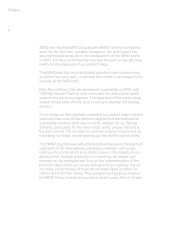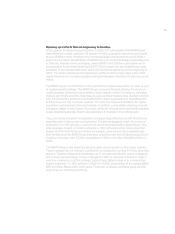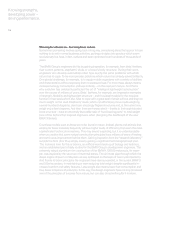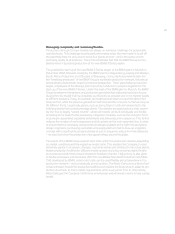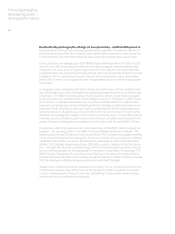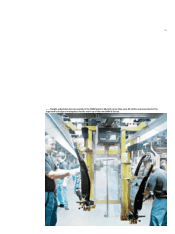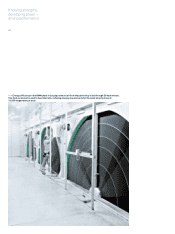BMW 2005 Annual Report Download - page 163
Download and view the complete annual report
Please find page 163 of the 2005 BMW annual report below. You can navigate through the pages in the report by either clicking on the pages listed below, or by using the keyword search tool below to find specific information within the annual report.15
Opening up markets that are beginning to develop.
At first glance, the beginnings are modest. In 2005, 227 automobiles of the BMW brand
were delivered in India. Less than 0.2 percent of India’s population has an annual income
of euro19,000 or more, therefore only a correspondingly small proportion could afford a
premium automobile. Nevertheless, the BMW Group is currently building an assembly plant
in Chennai, formerly known as Madras, where BMW 3 and 5 Series automobiles are to
be assembled for the local market from 2007. The Company has also established a sales
subsidiary in the Greater Delhi area, which will commence operations at the beginning of
2007. The dealer network is to be extended to all the country’s major urban areas. Initial
capital
investment in the sales subsidiary and assembly plant will amount to around euro 20
million.
The BMW Group’s commitment on the subcontinent makes sense when it is seen as part
of a global growth strategy. The BMW Group is pursuing the goal of being the most suc-
cessful supplier of premium automobiles in every relevant market. In doing so, emerging
markets are initially served by importers. As soon as these markets have reached a certain
size, the Company’s presence is intensified with a sales subsidiary or an assembly plant.
In India, this point has now been reached. The state has improved conditions for capital
investment and developed the road network. In addition, a new middle class has evolved
and grown rapidly in recent years. As a result, demand in the premium automobile segment
is also developing strongly. Experts are expecting it to multiply in the coming years.
Thus, it is simply consistent to establish a corresponding infrastructure with the Chennai
assembly plant in this up-and-coming market.The plant is designed initially for an annual
production of 1,700 vehicles, a volume that can be extended flexibly, depending on how
retail develops. Indeed, a market’s potential is often stimulated when local production
begins. On the North American market, for example, sales volume has multiplied more
than fivefold since the BMW Group’s decision to build its own plant in Spartanburg, South
Carolina. It has risen from 53,343 automobiles in 1991 to more than 300,000 vehicles in
2005.
The BMW Group is also expecting dynamic sales volume growth in other Asian markets.
There it already has, for example, a production and sales joint venture in China, assembly
plants in Thailand, Malaysia and Indonesia, an IT and parts distribution centre in Malaysia
and a newly opened design centre in Singapore. With its business activities in India, it
now has a presence in all the strategic hubs of Asia. Retail in Asia is to increase from
slightly more than 111,000 vehicles in 2005 to 150,000 automobiles of the brands BMW,
MINI and Rolls-Royce within three years. These are, as always, ambitious goals. But the
beginnings are extremely promising.


